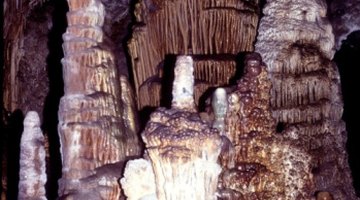How to Identify Sandstone Vs. Limestone
All rocks have unique properties that set them apart. Some are physical characteristics while others are chemical in nature. Limestone is used in the construction industry because of its abundance and hard physical nature. Sandstone is created from particles of other rocks and sand.

It is not as dense as limestone and is used as raw material for many industries. Telling the difference between these two types of rock can be accomplished just by looking at their physical attributes.
-
Exam the stone visually. Sandstone is created in layers. If you can see horizontal lines through the stone indicating these layers, you can be sure that it is sandstone and not limestone. Limestone is made mostly of calcium deposits from large collections of shell, bone and coral and creates a solid colored stone.
-
Exam the color of the stone. Because sandstone is made up of many types of rock and sand, its coloring can be blue, red, brown or even green. Limestone however is always white due to its calcium makeup.
-
Test the hardness of the stone. On a small section of the stone, strike the surface of the rock with a hammer. Since sandstone is made up of many small sand particles, it will break apart fairly easily while limestone is much harder and should not crumble.
The Drip Cap
- All rocks have unique properties that set them apart.
- Sandstone is created from particles of other rocks and sand.
- Exam the color of the stone.
- Since sandstone is made up of many small sand particles, it will break apart fairly easily while limestone is much harder and should not crumble.
Check out this related video from Homesteady on Youtube.
References
- Sandstone Physical Properties
- Limestone Physical Properties
- Geology: A Self-Teaching Guide; Barbara Winifred Murck; June, 2001
Writer Bio
Jonathan Shaffer has been a freelance writer and blogger since 1999. He has written concert reviews for prominent music blogs and magazines, including "Connections Magazine" in Orlando, Fla. Shaffer holds an Associate of Science in the recording arts from Full Sail University and is working on a Bachelor of Business from Valencia College.
Photo Credits
- Jupiterimages/Photos.com/Getty Images
- Jupiterimages/Photos.com/Getty Images
More Articles



